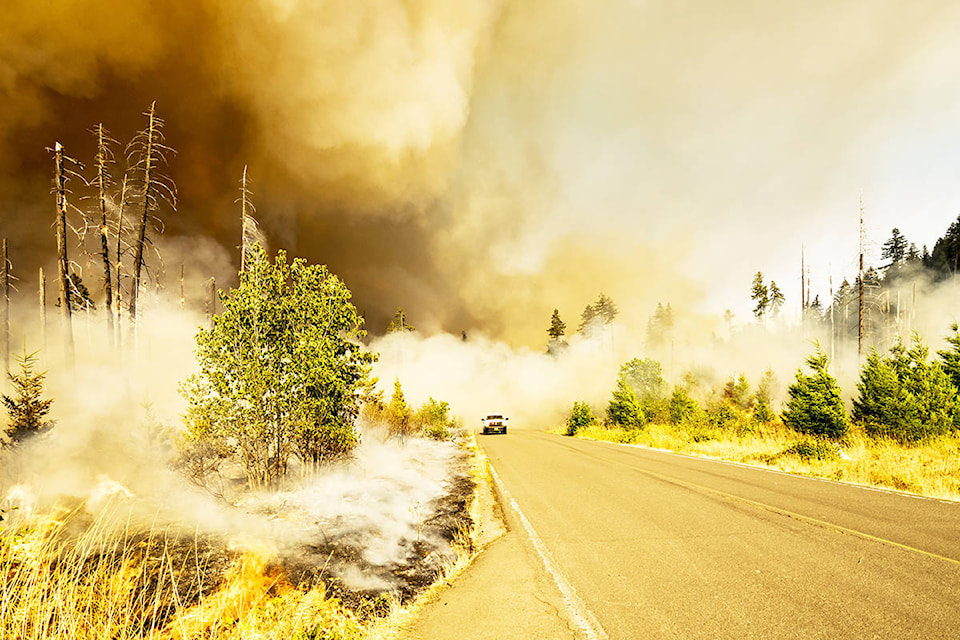Submitted
July 7 marked the one-year anniversary of the B.C. wildfires.
On that day in 2017, a two-hectare wildfire began west of 100 Mile House, kicking off B.C.’s record-breaking season.
Fires are a natural part of the forest ecosystems in Canada.
The burning recycles nutrients and improves the habitat for animals.
It is also good for trees in the long run.
It clears the forest floor of debris allowing existing trees to grow stronger and healthier; however, they can be devastating to those located near a wildfire-prone zone.
Perennially, they pose a significant risk to communities and businesses located close to forests.
FirstOnSite Restoration, an independent disaster restoration services provider, has been on the frontlines of the decades’ largest forest fires, including last years B.C. wildfires, the Fort McMurray wildfire and the Slave Lake wildfire in 2011.
Assisting with air quality assessment and restoration, FirstOnSite has significant experience with large-loss catastrophe scenarios.
How to Prepare for a Wildfire:
Here are 10 ways you can protect your property from a wildfire, whether you’re a commercial property owner, property manager or homeowner.
Create a 10-metre defensible space around your property
Fire needs fuel to burn. Clear away any highly combustible materials, such as twigs, branches, leaves, tree needles, brush, woodpiles and mulch.
Make your roof fire-resistant and clear away gutter debris
Wood shingles are extremely flammable. Roofs constructed from non-flammable materials, such asphalt, metal, slate or tile, offer the best possible protection against fire.
If replacing a wooden roof is not immediately possible, it can also be treated with fire retardant.
Debris can easily ignite from sparks or embers, so keep your gutters clean.
You can also screen them with metal mesh to reduce the amount of debris that can build up.
Keep embers out
Any opening can allow sparks and embers to enter your property.
Precautions include screening vents with wire mesh, protecting eaves with soffits and fascia made from fire-resistant materials, repairing any loose shingles, and sealing doggy doors during wildfire season.
Remove close by coniferous trees
Coniferous trees (with cones and needles) are extremely flammable, whereas deciduous (leafy) trees are naturally fire-resistant.
Any coniferous tree within 10 metres of your property is a serious fire hazard.
Beyond 10 metres, space out coniferous trees by at least three metres.
Prune your trees
If you do have trees surrounding your property, make sure to prune lower branches regularly.
For coniferous trees, remove branches within two metres of the ground.
Keep your lawn mowed
Grasses shorter than 10 centimetres are a much lower fire risk.
Well-watered grass also helps stop flames from spreading (provided your area does not have water restrictions).
Create a “bug-out” bag and an action/evacuation plan
The bag should contain a fire extinguisher, bottled water, non-perishable food, first aid kit, survival blanket, two-way radios, cell phone charger, N95 respirators and important documents (copies of insurance paperwork, personal identification).
An action plan should detail pre-planned evacuation routes, an emergency meeting location, an evacuation plan for pets and/or livestock, and last minute-steps such as moving away any fuel tank close to buildings, including propane tanks and jerry cans.
Find a “fire-resistant zone” near your home
This could be a tilled field or large paved area, free of vegetation.
This spot will allow you a resource should a wildfire approach quickly and regular routes are not viable.
Work with your neighbours
If a nearby property ignites, your property is under threat.
It is important to make fire preparation a community activity, especially if you live in a densely populated area.
Ensure you have adequate insurance coverage
Check your insurance policy to ensure your home and belongings are sufficiently insured, and that your policy is up to date.
newsroom@clearwatertimes.com
Like us on Facebook and follow us on Twitter
